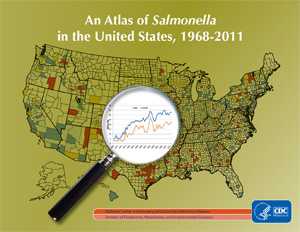Salmonella Atlas
An Atlas of Salmonella in the United States, 1968-2011 [PDF - 248 pages] summarizes 42 years of laboratory-confirmed surveillance data on Salmonella isolates (pure strains separated from specimens with more than one bacteria) from humans.
It includes:
- Analyses by age, sex, geography, and season
- Reports of Salmonella isolates from animals and related sources (e.g., environment and feeds)
This is the first time CDC has posted these data online in a downloadable format in its entirety or in 32 individual Salmonella serotype reports.
The Importance of Serotyping Salmonella
Scientists classify types of Salmonella into serotypes by identifying the structures on the bacteria’s surfaces. Since the 1960s, public health scientists in the US have used serotyping to link Salmonella cases with similar bacteria and likely to be related. Serotyping has been the core of public health monitoring of Salmonella infections since then. Now, scientists also use DNA testing to further divide each serotype into more subtypes. More about Serotyping
The Importance of the Atlas
Permits comparison of different serotypes
- Many serotypes differ by where and when they occur, and by the ages of those they affect. The reasons for this are not always clear.
- Consolidating Salmonella serotype information from over 40 years may help researchers consider possible explanations for the differences among patterns.
Allows analysis of trends over time
- Serotyping provides a consistent subtyping method that has changed little since national surveillance for Salmonella infections was established in the US in 1962.
- In the US, scientists conduct serotype-based Salmonella surveillance to:
- Define endemic patterns of salmonellosis,
- Detect outbreaks,
- Identify trends over time in disease transmission,
- Monitor the impact of outbreak control efforts, and
- Target prevention efforts on a specific serotype, like those focused on eggs and Salmonella Enteritidis.
Reports data from human, animal, and other environmental sources in one place
- State public health laboratories serotype Salmonella isolates from humans and report these to CDC.
- The National Veterinary Services Laboratories [PDF - 2 pages] of the United States Department of Agriculture’s Food Safety and Inspection Service reports Salmonella isolates from animals and related sources (e.g., environment and feeds).
- Veterinary diagnostic laboratories throughout the US submit animal isolates for serotyping.
Additional Serotype Reports
In addition to the Salmonella Atlas, CDC has produced annual reports for National surveillance for Salmonella infections by year for 2007, 2008, 2009, 2010, and 2011. These reports contain a description of national surveillance Adobe PDF file [PDF - 12 pages] and summary data tables not contained in the Atlas.
For More Information:
Press Release
Salmonella data now at your fingertips
March 26, 2014
References
- National Veterinary Services Laboratory
- Scallan E, Hoekstra RM, Angulo FJ, Tauxe RV, Widdowson MA, Roy SL, Jones JL, Griffin PM. Foodborne illness acquired in the United States- -major pathogens. Emerg Infect Dis. 2011 Jan;17(1):7-15.
- Page last reviewed: March 9, 2015
- Page last updated: March 9, 2015
- Content source:


 ShareCompartir
ShareCompartir
